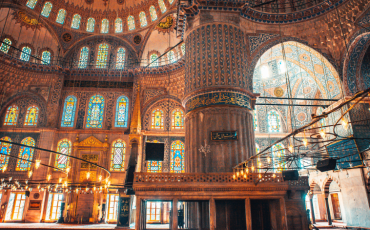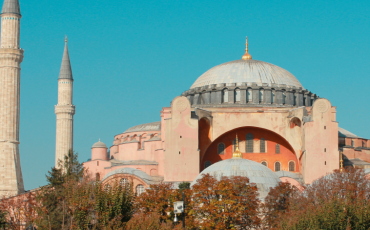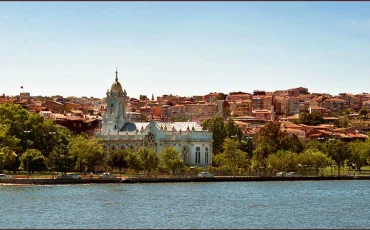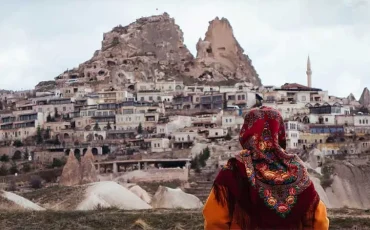What you read in this article:
Nestled at the crossroads of Europe and Asia, Istanbul, the vibrant metropolis straddling the Bosphorus Strait, is renowned for its rich history, diverse culture, and, notably, its plethora of mosques.
If you’ve ever wondered, “How many mosques are in Istanbul?” you’re in for an illuminating journey through the spiritual landscape of this fascinating city.
From the imposing minarets that grace the skyline to the serene courtyards echoing with calls to prayer, Istanbul’s mosques stand as a testament to its deep-rooted Islamic heritage.
Unveiling Istanbul’s Mosque Landscape
To embark on this exploration, it’s crucial to grasp Istanbul’s historical significance within the former Ottoman Empire. The city, once known as Constantinople, served as the capital of the Ottoman Empire for over four centuries. This period saw the construction of numerous mosques, each a testament to the empire’s cultural and religious identity.

But just how many mosques are scattered across this sprawling city? The answer may surprise you. Istanbul is home to over 3,000 mosques, a staggering number that reflects the profound influence of Islam on its history and architecture.
As we delve deeper, let’s uncover the intricacies of Istanbul’s mosque landscape, from their origins to their enduring impact on the city’s identity.
Read More: How Old is the Blue Mosque in Istanbul? Discovering the Age of the Blue Mosque
Istanbul’s Mosques
- Question: Have you ever wondered why Istanbul boasts such an immense number of mosques? The answer lies in its historical role as the center of the Ottoman Empire, where mosques served not only as places of worship but also as symbols of imperial grandeur.
- Short Story: Picture this – a stroll through Istanbul’s winding streets, each corner revealing a mosque with a unique story to tell. One such mosque, the Hagia Sophia, originally a Byzantine cathedral, transformed into an imperial mosque and now a museum, encapsulates the city’s diverse history and religious transitions.
- Statistics: Istanbul’s status as a mosque haven becomes even more apparent when you consider that it houses more than three times the number of mosques found in Mecca. This statistic underscores the city’s central role in Islamic history and its continuous commitment to preserving and promoting its religious heritage.
- Interesting Facts: Did you know that Istanbul is home to not just any mosques but some of the most significant imperial mosque complexes in the world? The Blue Mosque, also known as the Sultan Ahmed Mosque, and the Suleymaniye Mosque are architectural marvels that attract millions of visitors annually, offering a glimpse into the grandeur of Ottoman mosque design.

As we venture deeper into the heart of Istanbul’s mosque-laden landscape, the next sections will unfold the stories behind these architectural wonders and explore the evolving traditions that have shaped the city’s Islamic identity.
Join us on this enlightening journey through the cultural tapestry of Istanbul, where every mosque stands as a silent guardian of the city’s historical legacy.
Read More: Christian churches in Izmir Turkey
The Count and Growth of Mosques Over Time
Istanbul’s Mosques in Numbers:
Current Number of Mosques
Istanbul is home to over 3,000 mosques, each with its unique architectural charm and historical significance. This staggering number underscores the city’s commitment to preserving its rich religious identity.
Growth Trends and Historical Context
The journey of Istanbul’s mosques spans centuries, reflecting the ebb and flow of the city’s history. Over time, the number of mosques has grown organically, mirroring the cultural and religious transitions Istanbul has undergone.
Historically, the construction of mosques in Istanbul was closely tied to the rise and fall of empires. The Ottoman Empire, in particular, left an indelible mark on the city’s skyline, as rulers commissioned the construction of grand mosques to solidify their imperial legacy.
The growth of mosques in Istanbul is not merely a numerical phenomenon; it’s a narrative woven into the fabric of the city’s identity. As Istanbul transformed from Byzantium to Constantinople and finally to Istanbul, each era left its architectural imprint on the city’s mosques.
Read More: Biggest Mosque in Istanbul: Exploring the Iconic Süleymaniye Mosque
As we explore the numerical intricacies and historical context of Istanbul’s mosques, it becomes evident that these spiritual spaces are not just buildings; they are living monuments to the city’s dynamic past.
Join us on the next leg of our journey, where we unravel the architectural beauty and cultural significance of some of Istanbul’s most iconic mosques.

Istanbul’s Earliest Mosques
Historical Roots of Istanbul’s Mosques:
The Birth of Istanbul’s Mosques
Istanbul’s first mosques were born from the cultural amalgamation of Byzantine and Islamic influences. The conquest of Constantinople in 1453 marked a pivotal moment, ushering in a new era for the city’s religious landscape.
The Hagia Sophia, a masterpiece that transitioned from a Byzantine cathedral to an imperial mosque, exemplifies this transformative period. Its conversion symbolizes the coexistence and adaptation of diverse cultural and religious traditions.
Cultural and Historical Importance
Istanbul’s early mosques, such as the Yeni Mosque and the Fatih Mosque, stand as living artifacts, chronicling the city’s transition from Byzantine rule to Ottoman sovereignty.
These mosques are not merely architectural marvels; they encapsulate the socio-political and religious dynamics of their time. The Yeni Mosque, commissioned by Ottoman Sultan Mehmed III, serves as a testament to the imperial aspirations of the Ottoman rulers.
As we trace the origins of Istanbul’s earliest mosques, it becomes clear that each structure is a chapter in the city’s rich history. Join us in the upcoming sections as we navigate through the architectural wonders that have defined Istanbul’s skyline and delve into the evolving traditions that continue to shape the city’s mosque landscape.

Architectural Splendor of Istanbul’s Mosques
Architectural Diversity:
Ottoman Grandeur
Istanbul’s skyline is adorned with the grandeur of Ottoman architecture, evident in iconic structures like the Blue Mosque and the Suleymaniye Mosque. These mosques, characterized by large domes, intricate tilework, and towering minarets, showcase the opulence and sophistication of Ottoman design.
The Blue Mosque, officially known as the Sultan Ahmed Mosque, is a prime example of Ottoman architecture, with its six minarets and a stunning cascade of domes. It stands as a living testament to the architectural prowess of the Ottoman Empire.
Read More: Mosque in Istanbul That Was a Church: The Fascinating Hagia Sophia
Transition to Modern Designs
As Istanbul embraced the modern era, mosque architecture underwent a subtle yet significant transformation. Contemporary mosques like the Sakirin Mosque and the Istanbul Camlica Mosque reflect a harmonious blend of tradition and modernity.
The Sakirin Mosque, known for its modern design elements and emphasis on natural light, represents a departure from the traditional Ottoman style. Similarly, the Istanbul Camlica Mosque, perched atop the Camlica Hill, offers a panoramic view of the city and incorporates contemporary architectural features.
As we traverse the diverse architectural styles of Istanbul’s mosques, it becomes evident that these structures not only reflect the city’s history but also its ability to embrace change while preserving its cultural roots.
Join us in the next sections as we unravel the rituals, traditions, and community dynamics that breathe life into Istanbul’s vibrant mosque landscape.

Famous Mosques and Their Unique Features
Istanbul’s skyline is adorned with a collection of iconic mosques, each bearing the weight of history and architectural splendor. Join us as we cast a spotlight on some of Istanbul’s most revered mosques, unraveling the stories behind their creation and exploring the unique features that make them architectural gems.
The Blue Mosque (Sultan Ahmed Mosque)
The Unique Features of The Blue Mosque:
Distinctive Features
- Six minarets, a rarity in mosque architecture
- Striking blue tiles that adorn the interior walls, giving the mosque its name
- A vast central dome flanked by smaller domes, creating a mesmerizing visual effect
Historical Significance
Built during the reign of Sultan Ahmed I, the Blue Mosque is a testament to Ottoman grandeur and architectural innovation.
The Suleymaniye Mosque
The Unique Features of The Suleymaniye Mosque:
- Four minarets, each towering in grandeur
- A massive central dome supported by semi-domes, creating a sense of harmony
- A spacious courtyard with impressive views of the Golden Horn
Historical Significance
Commissioned by Suleiman the Magnificent, this mosque stands as a symbol of Ottoman imperial power.
The Hagia Sophia
The Unique Features of The Hagia Sophia:
- A massive dome that once held the title of the world’s largest
- Byzantine mosaics that reveal the building’s rich history
- A unique amalgamation of Byzantine and Ottoman architectural elements
Historical Significance
Originally a cathedral, the Hagia Sophia’s conversion into a mosque and later a museum encapsulates Istanbul’s cultural transitions.

The Istanbul Camlica Mosque
- Two towering minarets visible from various parts of the city
- A spacious interior that accommodates thousands of worshippers
- Modern architectural elements, including a glass dome and large windows
Read More: Best Mosques in Istanbul: 9 Top Mosques to See in Istanbul
Historical Significance
Completed in 2019, the Istanbul Camlica Mosque represents a contemporary addition to Istanbul’s mosque landscape.
These mosques not only define Istanbul’s skyline but also serve as cultural landmarks, inviting visitors to witness the city’s rich history and architectural prowess. As we conclude our exploration, the final section will shed light on the enduring role of mosques in Istanbul’s daily life, traditions, and community dynamics.
New Mosques in Istanbul
In a city where history and modernity coalesce, Istanbul’s skyline is continuously evolving with the addition of new mosques that pay homage to tradition while embracing contemporary trends. Join us as we explore the ever-growing skyline of Istanbul, where the construction of new mosques becomes a canvas for architectural innovation.

Current Construction Trends
Istanbul is witnessing a surge in the construction of new mosques, each contributing to the city’s rich spiritual tapestry. These projects reflect a harmonious blend of traditional Islamic architecture and modern design elements.
Contemporary mosques such as the Istanbul Camlica Mosque and the Kucuk Camlica Mosque showcase bold designs, incorporating elements like expansive glass facades, modern geometric patterns, and sustainable architectural practices.
Integration of Technology
New mosques in Istanbul are leveraging technology to enhance the worship experience and streamline daily operations. From advanced sound systems for the call to prayer to smart lighting and climate control systems, these innovations cater to the needs of both worshippers and mosque administrators.
The integration of technology extends to facilities management, with some mosques adopting smart systems for energy efficiency, security, and resource management.
Inclusive and Sustainable Design
- The design philosophy behind new mosques in Istanbul goes beyond aesthetics; it embraces inclusivity and sustainability. Architects are focusing on creating spaces that are accessible to all, regardless of physical abilities, and incorporating eco-friendly features to reduce environmental impact.
- Accessible Spaces: Mosques like the Istanbul Grand Camlica Mosque prioritize inclusivity with ramps, elevators, and facilities for people with disabilities.
- Eco-Friendly Practices: Sustainable features, such as green roofs and energy-efficient lighting, are becoming integral to the construction of new mosques.

As Istanbul’s skyline continues to evolve, the ongoing construction of new mosques not only reflects the city’s commitment to its Islamic heritage but also serves as a testament to its embrace of modernity.
Join us in the final section as we delve into the enduring role of mosques in Istanbul’s daily life, traditions, and community dynamics.
Mosques as Community Hubs
In Istanbul, mosques transcend their primary function as places of worship; they serve as vibrant community hubs, weaving a tapestry of cultural and social connections. Join us as we delve into the multifaceted role of mosques in Istanbul’s daily life, exploring the diverse cultural and social functions that make them integral to the city’s fabric.
Cultural Gatherings
- Festivals and Celebrations: Istanbul’s mosques become lively centers during religious and cultural festivals. The sound of prayers mingles with joyous festivities, as communities come together to celebrate occasions such as Eid al-Fitr and Eid al-Adha. The atmosphere is filled with the spirit of communal harmony and shared joy.
- Islamic Arts and Exhibitions: Some mosques host cultural events, including exhibitions showcasing Islamic arts, calligraphy, and historical artifacts. These initiatives contribute to the preservation and promotion of Istanbul’s rich cultural heritage.
Educational Programs
- Islamic Studies and Classes: Mosques in Istanbul often host educational programs, offering classes on Islamic studies, Quranic recitation, and Arabic language. These initiatives foster a sense of learning and intellectual growth within the community.
- Cultural Workshops: Workshops on traditional arts, crafts, and music contribute to the cultural enrichment of community members, creating spaces where knowledge and creativity converge.

Community Services
- Social Support Networks: Mosques serve as platforms for building social support networks. They often house charity initiatives, providing assistance to those in need and fostering a sense of community responsibility.
- Health and Well-being Programs: Some mosques offer health-related programs, including seminars, workshops, and clinics, promoting the overall well-being of community members.
As we explore the cultural and social functions of Istanbul’s mosques, it becomes clear that these sacred spaces extend far beyond their architectural significance.
In the final section, we will summarize the profound impact of the sheer number of mosques on Istanbul’s identity and underscore their role as pillars of the city’s Islamic heritage.
Istanbul’s Religious Traditions
In the heart of Istanbul, the mosques stand as stoic witnesses to the rich tapestry of religious traditions that define the city’s spiritual life. Join us as we unravel the daily rituals and special religious occasions that imbue Istanbul’s mosques with a sense of sacredness and cultural significance.
Daily Rituals
- Call to Prayer (Adhan): Five times a day, the melodious call to prayer echoes through the city, resonating from minarets to invite the faithful to communal worship. The Adhan, a centuries-old tradition, symbolizes the rhythm of daily life in Istanbul and serves as a poignant reminder of the city’s Islamic identity.
- Congregational Prayers: The mosques of Istanbul are centers of congregational prayer, where the Muslim community comes together to perform the five daily prayers. This communal act of worship fosters a sense of unity and shared spirituality.
Special Religious Occasions
Ramadan: The holy month of Ramadan holds a special place in Istanbul’s religious calendar. Mosques become beacons of light during this month of fasting, with nightly Tarawih prayers and community iftars fostering a sense of togetherness.
Eid Celebrations: Eid al-Fitr and Eid al-Adha are joyous occasions celebrated with fervor in Istanbul’s mosques. The festive atmosphere spills onto the streets as families gather for prayers, exchange greetings, and partake in communal feasts.

Spiritual Reflection
Night of Power (Laylat al-Qadr): The last ten nights of Ramadan, particularly the Night of Power, hold special significance. Mosques open their doors for extended nightly prayers, providing worshippers with an opportunity for spiritual reflection and devotion.
Hajj Pilgrimage Observance: Istanbul’s mosques play a role in commemorating the Hajj pilgrimage, with sermons and programs that allow the community to connect with the significance of this sacred journey.
As we explore the spiritual traditions within Istanbul’s mosques, it becomes evident that these sacred spaces not only bear witness to daily rituals but also serve as conduits for fostering a sense of community and spiritual connection. In our final section, we will summarize the overarching significance of the multitude of mosques in Istanbul, emphasizing their role in preserving the city’s Islamic heritage.
Preserving Heritage Istanbul’s
Preserving the architectural and cultural heritage of Istanbul’s mosques presents a unique set of challenges in the face of urban development and the passage of time. In this section, we explore the hurdles encountered in maintaining these sacred spaces and the dedicated efforts to ensure their legacy endures.
Urbanization Pressures
Population Growth and Urban Expansion: Istanbul’s dynamic urban landscape, marked by population growth and expansion, poses challenges to the preservation of historic mosques. Increased urbanization may lead to alterations in the surrounding environment, affecting the visual and cultural context of these sacred structures.
Environmental Factors
The impact of weathering, air pollution, and environmental factors over the years can take a toll on the structural integrity of mosques. The intricate details of historical architecture are particularly vulnerable to degradation, necessitating continuous conservation efforts.
Read More: Christian churches in Istanbul Turkey (+History)
Historical Significance vs. Modern Needs
Striking a balance between preserving the historical significance of mosques and meeting the modern needs of the community can be challenging. Introducing necessary amenities without compromising the authenticity of the structures requires careful planning and execution.

Conservation Efforts
- Restoration Projects: Various restoration projects across Istanbul aim to breathe new life into historical mosques. These projects often involve meticulous efforts to repair and restore architectural elements, ensuring that the mosques maintain their original grandeur.
- Conservation Workshops and Education: Initiatives such as conservation workshops and educational programs play a vital role in raising awareness about the importance of mosque preservation. By engaging the community, these efforts contribute to a collective sense of responsibility for safeguarding cultural heritage.
As we explore the challenges and conservation efforts surrounding Istanbul’s mosques, it becomes clear that the city is committed to ensuring that these architectural marvels endure for future generations.
In the final section, we will summarize the profound impact of Istanbul’s mosques, emphasizing their role in shaping the city’s identity and cultural landscape.
Istanbul’s Mosques as Tourist Attractions
In addition to their religious significance, Istanbul’s mosques play a crucial role in the city’s tourism landscape, attracting visitors from around the globe. Let’s delve into the unique experiences that mosques offer to tourists and how these visits contribute to cultural exchange.
Architectural Marvels
Istanbul’s mosques, with their stunning architecture and historical significance, serve as iconic landmarks. Tourists are drawn to marvel at the intricate details, towering minarets, and expansive domes that characterize these structures.
The Blue Mosque and Hagia Sophia, in particular, are must-visit destinations, showcasing the grandeur of Ottoman and Byzantine architecture.
Cultural and Historical Significance
Educational Tours: Tourists often engage in educational tours to learn about the cultural and historical significance of Istanbul’s mosques. Knowledgeable guides provide insights into the evolution of these structures and their role in shaping the city’s identity.
Cultural Exchange: Mosque visits facilitate cultural exchange, offering tourists an opportunity to gain a deeper understanding of Islamic traditions, art, and architecture. This exchange fosters mutual respect and appreciation for diverse cultural practices.

Religious and Spiritual Tourism
Participation in Worship: Some tourists choose to participate in mosque activities, such as attending prayer sessions or observing religious rituals. This hands-on experience provides a unique insight into the spiritual aspects of Istanbul’s mosques.
Interfaith Dialogue: Mosque visits contribute to interfaith dialogue, fostering conversations and connections between people of different religious and cultural backgrounds.
As we explore the role of Istanbul’s mosques as tourist attractions, it becomes evident that these sacred spaces serve as bridges for cultural exchange, connecting people from diverse backgrounds through shared experiences and mutual understanding.
In the concluding section, we will summarize the multifaceted impact of Istanbul’s mosques on the city’s identity and global perception.
Read More: Is hijab required in Turkey?
Anticipated Changes and Innovations
As Istanbul continues to evolve, so too does the landscape of its mosques. In this section, we’ll explore the anticipated trends in mosque construction and design, offering a glimpse into the future of these sacred spaces.
Architectural Innovation
Integration of Green Spaces: Future mosque designs may prioritize the integration of green spaces and sustainable features. Rooftop gardens, eco-friendly materials, and energy-efficient technologies could become integral components of mosque architecture, blending tradition with environmental consciousness.
Incorporation of Smart Technologies: Anticipated innovations include the incorporation of smart technologies for enhanced functionality. From interactive educational displays to smart lighting and climate control systems, mosques may embrace technological advancements to improve the overall visitor experience.
Inclusive Design Principles
Accessible Facilities: Future mosques may place a heightened emphasis on accessibility, ensuring that all members of the community, including those with disabilities, can fully participate in mosque activities. Ramps, elevators, and other inclusive features may become standard in mosque design.
Multi-Functional Spaces: Anticipated changes include the creation of multi-functional spaces within mosques, accommodating a diverse range of community activities beyond traditional worship. These spaces could host educational programs, cultural events, and social gatherings.

Cultural Preservation and Innovation
Preservation of Historical Significance: While embracing innovation, future mosques may strive to preserve their historical and cultural significance. Adaptive reuse of existing structures, coupled with meticulous restoration, could become a prevalent trend.
Integration of Traditional Art Forms: Innovations in mosque design may involve the integration of traditional art forms, such as intricate calligraphy and mosaic work, with contemporary elements, creating a harmonious blend of the old and the new.
As we peer into the future of Istanbul’s mosque landscape, the anticipated changes and innovations reflect a delicate balance between preserving cultural heritage and embracing the possibilities of modernity.
In the concluding section, we will summarize the diverse facets of Istanbul’s mosque heritage, emphasizing their profound impact on the city’s identity and cultural mosaic.
Istanbul’s Ever-Evolving Mosque Culture
As we conclude our journey through the intricate world of Istanbul’s mosques, we find ourselves immersed in a rich tapestry woven with threads of tradition, architectural grandeur, and profound spirituality. Let’s summarize the key points that illuminate the cultural significance of these sacred spaces:
Unveiling Istanbul’s Mosque Landscape
Istanbul stands as a testament to a staggering number of mosques, over 3,000, each bearing witness to the city’s historical prominence.
Istanbul’s Mosques in Numbers
The growth trends and historical context of mosque construction in Istanbul showcase the dynamic nature of the city’s spiritual landscape.
Historical Roots of Istanbul’s Mosques
Tracing the origins of Istanbul’s earliest mosques reveals a narrative deeply intertwined with the city’s cultural and historical roots.
Architectural Diversity
The diverse architectural styles, from Ottoman grandeur to contemporary designs, exemplify the evolution of mosque construction in Istanbul.
Spotlight on Istanbul’s Signature Mosques
Iconic mosques with historical and architectural significance contribute to Istanbul’s unique identity.
Ever-Growing Skyline
Ongoing construction trends and innovative designs usher in a new era for mosque architecture in Istanbul.
Mosques as Community Hubs
Mosques in Istanbul transcend their religious role, becoming vibrant centers for cultural, educational, and social activities.

Istanbul’s Religious Traditions
Daily rituals, special occasions, and spiritual practices within mosques form the foundation of Istanbul’s religious traditions.
Challenges in Maintaining Istanbul’s Mosques
Conservation efforts and the challenges posed by urbanization highlight the city’s commitment to preserving its architectural heritage.
Istanbul’s Mosques as Tourist Attractions
Mosques serve as cultural bridges, attracting tourists and fostering cultural exchange.
Future Trends in Istanbul’s Mosque Landscape
Anticipated changes and innovations hint at a future where mosques seamlessly blend tradition with modernity.
Istanbul’s mosques stand as living monuments to the city’s vibrant history, architectural splendor, and enduring spirituality. Each dome and minaret tells a tale, connecting the past with the present and inviting visitors to be a part of Istanbul’s cultural mosaic.
As you explore the rich tapestry of mosques in this magnificent city, may you find inspiration, understanding, and a renewed appreciation for the diverse facets of Istanbul’s Islamic heritage.





Comments